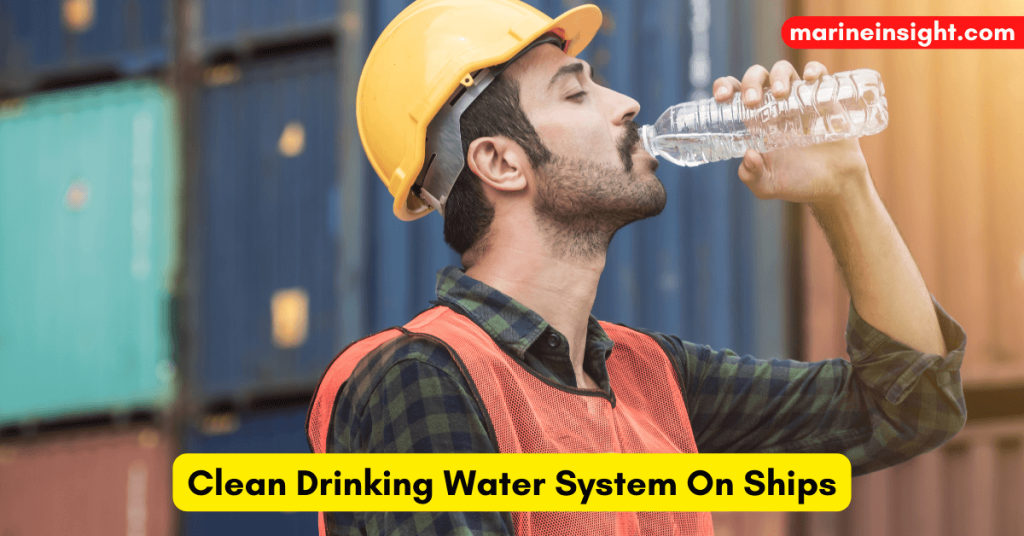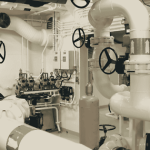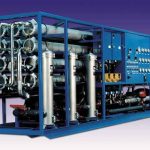Fresh Water Generation systems are provided on all ships sailing at seas. Adequate generation and storage arrangements of fresh water are provided onboard which help vessels to cope up with fresh water requirements during passage and long stays in port or anchorage.
The generation of drinking water while the Main engine is running (utilising the waste heat generated from the circulating cooling water for the diesel engine) has been the most effective and economical method for generating potable fresh water at sea

Several routines are followed while carrying out the maintenance and cleaning of fresh water generation system on board ships. Some of the important points that should be considered during maintenance of drinking water systems on ships are:
Check Salinity Alarm: The salinity alarm or salinity indicator needs regular checks as it allows only pure fresh water to flow into the fresh water tank. The electrodes of salinity alarm must be cleaned on monthly basis to remove dust or scale deposits. Alarm settings must be verified before putting the Fresh Water Generation system into operation after cleaning.
Stop Fresh Water Generator At Right Time: Whenever a vessel approaches any port, land or estuary, the Fresh Water Generator must be stopped as at such places the sea water is heavily infected with bacteria ,which may be transferred to the fresh water stored onboard. As per recommended in Safety Management System Manual or Flag State Requirements, the Fresh Water Tanks are generally cleaned once in six months or on yearly basis.
Use High Pressure Spray While Cleaning Tanks: While cleaning the fresh water tanks it is advisable to use high pressure spray of fresh water. The spray machine is electrically operated on some ships. Care should be taken for proper insulation of them during use and any risks of electrical shock should be eliminated.
Be Careful While Using Chemicals and Scrubbing: Chemicals, if any, are to be used should be biodegradable. Mostly fresh water tanks do not get rusted and have a special coating inside. It should be kept in mind not to scrub the tank surface too hard so that it results in removal of coating from the tank walls.
Take Proper Steps While Applying Paint: Paint if applied on the tank surface must be of approved type, immiscible in water and suitable to the surface. Allow the paint to be completely dry before filling the tank again with water in order to prevent amalgamation of any smell of paint with the drinking water.
Follow Proper Enclosed Space Entry Procedures: If ship’s staff is involved in cleaning fresh water tanks, enclosed space entry checklist and procedures must be complied with. Care should be taken for adequate illumination and means of ventilation inside the tank. All filling or equalising lines to the tank should be isolated or disconnected if required.
Wear Proper PPEs: Protective clothing and safety shoes or boots used by the ship’s crew must be clean and free of any grease, dirt, paint or chemicals.
Open Separator Shell When Required: The separator shell and heat exchanger covers can be opened up and inspected during scheduled inspections for scale formation or if cooling tubes are fouled with any sludge formation.
Cleaning of Heating Tubes Should Be Done On Regular Intervals of Time: Cleaning or descaling of the inside of heating tubes should be made twice or three times in a year physically or dissolved by chemical methods. Scaling can be prolonged by not operating the plant at contaminated water areas such as in harbours or ports.
Use Scale Inhibitors: Scale inhibitors are used to prevent scale formation by dispersing scale deposits and delaying reaction. This also prevents scale deposits from adhering to heat transfer surfaces, also called as the “Threshold effect “. Scale formation inside heat exchanger requires cleaning if specific temperatures cannot be obtained for inlet and outlet of fresh water.
Remove Damaged Coating: In case coating inside fresh water generator is damaged, the damaged covering is to be scraped off and the surface should be then thoroughly dried. After putting the undercoat on the steel surface, epoxy-resin or food coating (as prescribed by FWG manufacturer) is to be applied.
Inspect Impeller Periodically: The impeller of ejector pump wears out in due course of time and its surface also gets damaged due to high speed revolution. This is inevitable due to continuous operation of the pump. The condition of the impeller should thus be inspected periodically, keeping in mind the running hours.
Check Cooling Pipe: The cooling pipe should be checked for loosening in expansion area during inspection.
Clean Drinking Water Fountains: Various drinking water fountains inside accommodation require scheduled cleaning and replacement of filters as well.
Cleaning of Fresh Water Tank: The fresh water tank must be inspected and cleaned at regular intervals of time (normally 6 months). Ensure that the person entering the tank for cleaning does not have any skin disease and he/she must wear new clean pair of shoes before making an entry in the tank. Every alternate tank cleaning (yearly) must include disinfection with a solution of 50pm chlorine.
Fresh water on board ships is used for a variety of important purposes and more than often its scarcity is felt. Along with routine maintenance of fresh water systems, it is important that the ship’s crew take all necessary steps to reduce freshwater consumption and prevent fresh water contamination on board.


